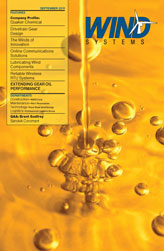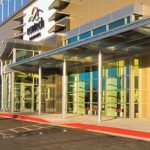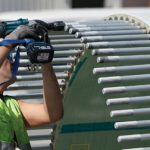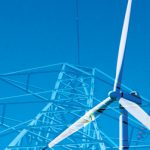The White Creek Wind I and Harvest Wind farms are owned by four consumer-owned utilities and operated by the NAES Corporation. NAES plant staff investigated solutions to upgrade the existing communications system at these facilities located in south central Washington State, selecting Bergelectric—one of the nation’s top electrical contractors—to develop and install a state of the art Internet-over-fiber solution. This communications solution provides an example of how to outfit a wind station with outstanding and cost effective safety and communications capabilities. Bergelectric designed the VoIP (Voice over Internet Protocol) system, partnering with IndustrialENET for its resilient industrial network solution and experience in the wind industry. IndustrialENET has developed communications solutions for the wind industry since 1997, including supplying Ethernet switches for more than 10,000 wind turbines.
As with many wind farms, the White Creek Wind I and Harvest Wind facilities are constructed over a large geographical area, in this case approximately 40 square miles. In order to find a site with large enough parcels, and with lower property costs, these two sites were developed in a remote area void of cellular or hardwired phone service.
At the White Creek Wind I site, and magnified with the addition of the Harvest Wind Project site, there was concern with the poor coverage for site communications. Both sites used two-way radios with the signal amplified by a single radio repeater. For maximum coverage, the repeater was installed in a wind turbine that had a battery backup system to maintain communications during grid outages. Even with selecting a turbine that provided maximum “line of sight” coverage, however, there were holes where radio contact could not be maintained.
Further, the radio system provided communication between radios only; that is, crew to crew, or between the crew and the O&M building. During periods of limited staffing, such as when on-call crews must respond to an issue on a Sunday, offsite communication was not available. In the event of an emergency, a technician could not call for emergency services using the radio system. Cell phone coverage, which was also very limited, did not provide a suitable alternative form of communication. Plant staff had to ensure that there was always a staff member at the O&M building whenever crews were working—a rather inefficient use of plant labor.
Investigating Alternatives
For the past year NAES plant staff studied solutions to address the communication coverage, including technologies that provided additional benefits such as Wi-Fi routers in the towers, cell phone repeaters mounted on the met tower, radio repeaters, satellite phones, and others. Two viable technologies were investigated further.
First was an improved radio system that provides minimum coverage from a safety standpoint. This system involves installing a second repeater to provide coverage over the entire site, along with a link to allow for simultaneous use of multiple repeaters. With the addition of a phone switch, the radios can also be used as a telephone allowing for offsite communication during emergencies or for technical support. As with any radio system, however, multiple conversations cannot occur simultaneously. If a technician is on a support call, which could easily last 30 minutes or more, no other onsite (two-way radio) or offsite (emergency) calls can be made.
The second technology that was investigated provided Internet access over fiber optic cabling to meet not only the minimum coverage for safety, but also to provide significant benefits for technician tools and turbine monitoring. This system makes use of two spare fiber optic cables already in place at the base of each tower, extends those fibers up the tower into the nacelle, and terminates them in a fiber-Ethernet switch that includes a VoIP phone and an Ethernet port (fig. 1). The phone allows for communication between towers, the O&M building, and offsite. The Ethernet port allows technicians to access the site servers providing instant access to electronic manuals, the SCADA system, turbine work history, the Computerized Maintenance Management System (CMMS), and more. Further, with a static IP (Internet protocol) address in each tower, any Internet-based electronics such as cameras, vibration monitors, and sensors can be easily installed and then accessed from any Web-based interface.
In the final analysis the enhanced radio system met the minimum requirements for safety coverage, yet failed to provide the capability to conduct multiple simultaneous conversations. The Internet-over-fiber solution, though significantly more expensive than the enhanced radio option, met not only the minimum safety coverage, but also provided technicians with access to all pertinent manuals, history, and operational programs, as well as providing a platform for future monitoring needs. The Internet-over-fiber option was the final recommendation.
Designing the System
The communications infrastructure at wind farms typically utilizes fiber optic cabling connections amongst the wind turbine generators, and in most cases, between the O&M facility and substation as well. In some cases wireless capabilities are also built into the communications system. When designing the technical requirements for the communications system many key factors need to be considered, including enhanced 911 (E911) calling features, availability, quality of service, ambient conditions, open standards, security, and system vulnerabilities.
It is also good design practice to provide multiple Ethernet ports to allow connectivity to other edge devices, such as cameras, laptops, Wi-Fi devices, and perhaps even IP-enabled testing equipment and instruments.
Crucial Features
Enhanced 911 (E911) is paramount in cost justification and is an important component to the system. Features should include user definable CALLER ID of 911 calls by location, automated call recording of all 911 calls, and notification of 911 calls in progress to all operator group members, including the extension that made the 911 call.
The call should be recorded in Call Data Recording (CDR) format and generate a “syslog event” as well. With proper set up on a syslog server, this event can be emailed to the appropriate emergency services as soon as the call is made. Syslog is a standard for logging program messages that separates the software that generates the messages from the system that stores them and the software that reports and analyzes them. It also provides devices that would otherwise be unable to communicate a means to notify administrators of problems or performance. Syslog can be used for computer system management and security auditing, as well as generalized informational, analysis, and debugging messages. It is supported by a wide variety of devices like printers, routers, and receivers across multiple platforms. Because of this, syslog can be used to integrate log data from many different types of systems into a central repository.
Redundancy Important
A failure in the communications system can sever the very link needed to communicate an emergency. Knowing when there is a single point or multiple points of failure is important so that corrective action can be taken immediately. This is possible only if the network is composed of managed switches with robust redundancy protocol/s enabled, and with the fiber media constructed into a ring since folded rings are common in the wind industry.
When wireless is used, the system needs to include two radios on each side of the communications link, with one radio configured as the primary link and the other as the backup link. In this case, the Rapid Spanning Tree Protocol (RSTP) is common.
Redundancy and link failures need to be alarmed back to a network management system that is capable of notifying staff, either by continuous monitoring or via email, if there is a link failure between the switches, radios or an edge device, such as the telephone. The first backbone link failure will go unnoticed until a second failure occurs, by which time either a portion or all of the network will have been severed, possibly resulting in the inability to make a call. Refer to Figure 1 when considering the following:
1) Each nacelle includes a VoIP telephone and managed Ethernet switch located in a water tight enclosure with a clear door, as well as one FX multi-mode port and three TX RJ45 ports (FX = Fast Ethernet over optical fiber, and multi-mode fiber is typically used for distances less than 6 miles and is less expensive than single mode fiber, which is typically used for distances greater than 6 miles);
2) If desired, a down tower managed switch can include two FX single-mode ports, one FX multi-mode port, and six TX RJ45 ports;
3) Managed switch configured as the redundancy manager, located in an IT room or substation and connected to the nacelle system via both a standard link and a redundant link;
4) The connection to the telephone company/service provider includes the Telco Connectivity Appliance, a VoIP IP PBX Gateway, a Syslog Server that supports E911, and a Layer 3 (preferred) managed switch;
5) IP camera mounted with a spring clamp and connected with 20 foot Cat 5e cable;
6) Edge devices (laptop computers, etc.) can be connected to allow access to system manuals and Internet connectivity.
Industrial Communications Equipment
To avoid equipment failure at the turbines, use only robust industrial rated communications equipment that can survive the ambient conditions, shock, vibration, and equipment line power anomalies at the site. Deploy only industrial-rated Ethernet switches that follow industry standard practices and approvals. The same requirements should apply to all the devices, whether located in the turbine or in any harsh environment, such as in the substation or elsewhere.
Planning the VoIP System
The VoIP system is composed of a gateway—which is a computer or a network that allows or controls access to another computer or network—connecting the telephone service to the local area network (LAN), and in most cases the wide area network (WAN) as well. It is very desirable that the gateway will support the VoIP Session Initiation Protocol (SIP), which is an IEEE Open Standard. This way, you can choose from a number of different suppliers when selecting the telephones. The telephones can either plug directly into an Ethernet switch or be wireless, as in the case of also including a Wi-Fi cloud over the site. A good gateway architecture that includes redundancy from the Telco (telephone company) side is recommended, along with using a combination of any two of the following services: Plain Old Telephone System (POTS) lines, T1, PR1, DSL, and an Internet Telephony Service Providers (ITSP) SIP trunk. Keep in mind that the lower the power requirements for these options, the better. Back up both the VoIP gateway and the syslog server with a UPS (uninterruptible power supply) system designed to keep the system up and running for a predetermined amount of time, typically several hours. How long might an emergency last?
Encrypted Connection
A Linux operating system running on the VoIP gateway is a better choice than using an Open Source Architecture, such as Windows. This way, there is a greatly reduced risk to vulnerabilities and hacker attacks.
The Secure Shell (SSH) allows a secure remote channel to be opened between the gateway and any remote programming station. SSH uses encryption to provide a secure connection to the gateway over an unsecured network, such as the Internet. This secure level of support is highly desirable when provisioning SIP trunks and performing troubleshooting and maintenance.
Ensuring Voice Quality
Quality of service is very important when using VoIP, as packet loss and delays can make the voice transmissions useless. Therefore the network system of switches and/or appliances should support prioritization, especially if the network is intended to share other media such as video and Internet connectivity.
With prioritization, you can select which data packets are sent first over the system, ideally the VoIP has the highest priority. If a large amount of video data is to be transmitted over the network, then implementation of an IEEE 802.1Q VLAN (Virtual Local Area Network) is recommended to virtually separate the video traffic from the VoIP traffic. VLAN architecture can also be used to secure the VoIP network from the network ports intended for the edge devices (laptop computers, etc.) and that traffic.
Internet-over-Fiber Solution
Between July 19 and December 2, 2010, NAES plant staff worked with Bergelectric to install Internet access in the 132 wind turbines at the White Creek Wind I and Harvest Wind facilities, as well as a telephone equipped with the Enhanced 911 (E911) technology. Each nacelle is now equipped with a NEMA 4 box that includes the fiber-to-Ethernet switch, a VoIP telephone, a power supply, and a surge protector. The box also doubles as a laptop stand.
The project is already showing the potential to lower insurance premiums and labor services costs. The E911-enabled phone and IP connection for various devices such as computers, cameras, and sensors are not only increasing safety for maintenance personnel, but are also enabling them to be more efficient. Technicians can now access electronic work instructions, contact technical support, access manuals and diagrams, and operate the SCADA system, all while at the top of a wind turbine, eliminating the time consuming up-and-down process to climb the tower or the use of a radio-to-phone middleman.








































